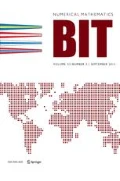Abstract
In this paper, we present a novel investigation of the so-called SAV approach, which is a framework to construct linearly implicit geometric numerical integrators for partial differential equations with variational structure. SAV approach was originally proposed for the gradient flows that have lower-bounded nonlinear potentials such as the Allen–Cahn and Cahn–Hilliard equations, and this assumption on the energy was essential. In this paper, we propose a novel approach to address gradient flows with unbounded energy functionals such as the KdV equation by a decomposition of energy functionals. Further, we will show that the equation of the SAV approach, which is a system of equations with scalar auxiliary variables, is expressed as another gradient system that inherits the variational structure of the original system. This expression allows us to construct novel higher-order integrators by a certain class of Runge-Kutta methods. We will propose second and fourth order schemes for conservative systems in our framework and present several numerical examples.













Similar content being viewed by others
References
Akrivis, G., Li, B., Li, D.: Energy-decaying extrapolated RK-SAV methods for the Allen–Cahn and Cahn–Hilliard Equations. SIAM J. Sci. Comput. 41(6), A3703–A3727 (2019). https://doi.org/10.1137/19M1264412
Allen, S.M., Cahn, J.W.: A microscopic theory for antiphase boundary motion and its application to antiphase domain coarsening. Acta Metallurgica 27(6), 1085–1095 (1979). https://doi.org/10.1016/0001-6160(79)90196-2
Besse, C.: A relaxation scheme for the nonlinear Schrödinger equation. SIAM J. Numer. Anal. 42(3), 934–952 (2004). https://doi.org/10.1137/S0036142901396521
Bo, Y., Wang, Y., Cai, W.: Arbitrary high-order linearly implicit energy-preserving algorithms for Hamiltonian PDEs. arXiv:2011.08375 (2020)
Cahn, J..W., Hilliard, J..E.: Free energy of a non-uniform system. I. Interfacial free energy. J. Chem. Phys. 28, 258–267 (1958)
Cai, W., Jiang, C., Wang, Y., Song, Y.: Structure-preserving algorithms for the two-dimensional sine-Gordon equation with Neumann boundary conditions. J. Comput. Phys. 395, 166–185 (2019). https://doi.org/10.1016/j.jcp.2019.05.048
Camassa, R., Holm, D.D.: An integrable shallow water equation with peaked solitons. Phys. Rev. Lett. 71(11), 1661–1664 (1993). https://doi.org/10.1103/PhysRevLett.71.1661
Celledoni, E., Grimm, V., McLachlan, R.I., McLaren, D.I., O’Neale, D., Owren, B., Quispel, G.R.W.: Preserving energy resp. dissipation in numerical PDEs using the “average vector field” method. J. Comput. Phys. 231(20), 6770–6789 (2012). https://doi.org/10.1016/j.jcp.2012.06.022
Cheng, Q.: The generalized scalar auxiliary variable approach (G-SAV) for gradient flows. arXiv:2002.00236 (2020)
Cheng, Q., Shen, J.: Multiple scalar auxiliary variable (MSAV) approach and its application to the phase-field vesicle membrane model. SIAM J. Sci. Comput. 40(6), A3982–A4006 (2018). https://doi.org/10.1137/18M1166961
Dahlby, M., Owren, B.: A general framework for deriving integral preserving numerical methods for PDEs. SIAM J. Sci. Comput. 33(5), 2318–2340 (2011). https://doi.org/10.1137/100810174
Fu, Y., Cai, W., Wang, Y.: A structure-preserving algorithm for the fractional nonlinear Schrödinger equation based on the SAV approach. arXiv:1911.07379 (2019)
Furihata, D.: Finite difference schemes for \(\partial u/\partial t=(\partial /\partial x)^\alpha \delta G/\delta u\) that inherit energy conservation or dissipation property. J. Comput. Phys. 156(1), 181–205 (1999). https://doi.org/10.1006/jcph.1999.6377
Furihata, D., Matsuo, T.: Discrete variational derivative method-A structure-preserving numerical method for partial differential equations. CRC Press (2011)
Furihata, D., Mori, M.: General derivation of finite difference schemes by means of a discrete variation (in Japanese). Trans. Jpn. Soc. Indust. Appl. 8(3), 317–340 (1998)
Gong, Y., Zhao, J., Wang, Q.: Arbitrarily high-order unconditionally energy stable SAV schemes for gradient flow models. Comput. Phys. Commun. p. 107033 (2019). https://doi.org/10.1016/j.cpc.2019.107033
Gong, Y., Zhao, J., Wang, Q.: Arbitrarily high-order linear energy stable schemes for gradient flow models. J. Comput. Phys. 419, 109,610, 20 (2020). https://doi.org/10.1016/j.jcp.2020.109610
Gonzalez, O.: Time integration and discrete Hamiltonian systems. J. Nonlinear Sci. 6(5), 449–467 (1996). https://doi.org/10.1007/s003329900018
Hairer, E.: Energy-preserving variant of collocation methods. JNAIAM. J. Numer. Anal. Ind. Appl. Math. 5(1–2), 73–84 (2010)
Hairer, E., Lubich, C.: Energy-diminishing integration of gradient systems. IMA J. Numer. Anal. 34(2), 452–461 (2014). https://doi.org/10.1093/imanum/drt031
Hairer, E., Lubich, C., Wanner, G.: Geometric numerical integration, Structure-preserving algorithms for ordinary differential equations, Springer Series in Computational Mathematics, vol. 31. Springer (2010)
Han, D., Brylev, A., Yang, X., Tan, Z.: Numerical analysis of second order, fully discrete energy stable schemes for phase field models of two-phase incompressible flows. J. Sci. Comput. 70(3), 965–989 (2017). https://doi.org/10.1007/s10915-016-0279-5
Jiang, C., Gong, Y., Cai, W., Wang, Y.: A linearly implicit structure-preserving scheme for the Camassa–Holm equation based on multiple scalar auxiliary variables approach. J. Sci. Comput. 83(1), 20 (2020). https://doi.org/10.1007/s10915-020-01201-4
Li, X., Shen, J., Rui, H.: Energy stability and convergence of SAV block-centered finite difference method for gradient flows. Math. Comp. 88(319), 2047–2068 (2019). https://doi.org/10.1090/mcom/3428
Liu, Z.: Efficient invariant energy quadratization and scalar auxiliary variable approaches without bounded below restriction for phase field models. arXiv:1906.03621 (2019)
Liu, Z.: Energy stable schemes for gradient flows based on novel auxiliary variable with energy bounded above. arXiv:1907.04142 (2019)
Liu, Z., Li, X.: Efficient modified techniques of invariant energy quadratization approach for gradient flows. Appl. Math. Lett. 98, 206–214 (2019). https://doi.org/10.1016/j.aml.2019.06.006
Liu, Z., Li, X.: Step-by-step solving schemes based on scalar auxiliary variable and invariant energy quadratization approaches for gradient flows. arXiv:2001.00812 (2019)
Liu, Z., Li, X.: The exponential scalar auxiliary variable (E-SAV) approach for phase field models and its explicit computing. SIAM J. Sci. Comput. 42(3), B630–B655 (2020). https://doi.org/10.1137/19M1305914
Matsuo, T., Furihata, D.: Dissipative or conservative finite-difference schemes for complex-valued nonlinear partial differential equations. J. Comput. Phys. 171(2), 425–447 (2001). https://doi.org/10.1006/jcph.2001.6775
Matsuo, T., Sugihara, M., Furihata, D., Mori, M.: Spatially accurate dissipative or conservative finite difference schemes derived by the discrete variational method. Jpn. J. Indust. Appl. Math. 19, 311–330 (2002). https://doi.org/10.1007/BF03167482
McLachlan, R.I., Quispel, G.R.W., Robidoux, N.: Unified approach to Hamiltonian systems, Poisson systems, gradient systems, and systems with Lyapunov functions or first integrals. Phys. Rev. Lett. 81(12), 2399–2403 (1998). https://doi.org/10.1103/PhysRevLett.81.2399
McLachlan, R.I., Quispel, G.R.W., Robidoux, N.: Geometric integration using discrete gradients. R. Soc. Lond. Philos. Trans. Ser. A Math. Phys. Eng. Sci. 357(1754), 1021–1045 (1999). https://doi.org/10.1098/rsta.1999.0363
Shen, J., Xu, J.: Convergence and error analysis for the scalar auxiliary variable (SAV) schemes to gradient flows. SIAM J. Numer. Anal. 56(5), 2895–2912 (2018). https://doi.org/10.1137/17M1159968
Shen, J., Xu, J., Yang, J.: The scalar auxiliary variable (SAV) approach for gradient flows. J. Comput. Phys. 353, 407–416 (2018). https://doi.org/10.1016/j.jcp.2017.10.021
Shen, J., Xu, J., Yang, J.: A new class of efficient and robust energy stable schemes for gradient flows. SIAM Rev. 61(3), 474–506 (2019). https://doi.org/10.1137/17M1150153
Swift, J., Hohenberg, P.C.: Hydrodynamic fluctuations at the convective instability. Phys. Rev. A 15, 319–328 (1977)
Yang, X.: Linear, first and second-order, unconditionally energy stable numerical schemes for the phase field model of homopolymer blends. J. Comput. Phys. 327, 294–316 (2016). https://doi.org/10.1016/j.jcp.2016.09.029
Yang, X., Han, D.: Linearly first- and second-order, unconditionally energy stable schemes for the phase field crystal model. J. Comput. Phys. 330, 1116–1134 (2017). https://doi.org/10.1016/j.jcp.2016.10.020
Yang, Z., Dong, S.: A roadmap for discretely energy-stable schemes for dissipative systems based on a generalized auxiliary variable with guaranteed positivity. J. Comput. Phys. 404, 109,121 (2020). https://doi.org/10.1016/j.jcp.2019.109121
Zhang, F., Pérez-García, V.M., Vázquez, L.: Numerical simulation of nonlinear Schrödinger systems: a new conservative scheme. Appl. Math. Comput. 71(2–3), 165–177 (1995). https://doi.org/10.1016/0096-3003(94)00152-T
Zhang, H., Qian, X., Song, S.: Novel high-order energy-preserving diagonally implicit Runge-Kutta schemes for nonlinear Hamiltonian ODEs. Appl. Math. Lett. 102, 106,091, 9 (2020). https://doi.org/10.1016/j.aml.2019.106091
Zhao, J., Wang, Q., Yang, X.: Numerical approximations for a phase field dendritic crystal growth model based on the invariant energy quadratization approach. Internat. J. Numer. Methods Engrg. 110(3), 279–300 (2017). https://doi.org/10.1002/nme.5372
Zhuang, Q., Shen, J.: Efficient SAV approach for imaginary time gradient flows with applications to one- and multi-component Bose-Einstein condensates. J. Comput. Phys. 396, 72–88 (2019) https://doi.org/10.1016/j.jcp.2019.06.043
Acknowledgements
The first author was supported by JSPS Grant-in-Aid for Early-Career Scientists (No. 19K14590). The second author was supported by JSPS Grant-in-Aid for Research Activity Start-up (No. 19K23399).
Author information
Authors and Affiliations
Corresponding author
Additional information
Communicated by Christian Lubich.
Publisher's Note
Springer Nature remains neutral with regard to jurisdictional claims in published maps and institutional affiliations.
Rights and permissions
About this article
Cite this article
Kemmochi, T., Sato, S. Scalar auxiliary variable approach for conservative/dissipative partial differential equations with unbounded energy functionals. Bit Numer Math 62, 903–930 (2022). https://doi.org/10.1007/s10543-021-00904-w
Received:
Accepted:
Published:
Issue Date:
DOI: https://doi.org/10.1007/s10543-021-00904-w



